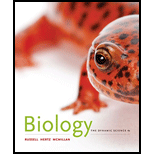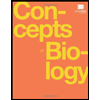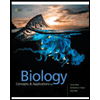
Concept explainers
In the fluid mosaic model:
plasma membrane proteins orient their hydrophilic sides toward the internal bilayer.
phospholipids often flip-flop between the inner and outer layers.
the mosaic refers to proteins attached to the underlying cytoskeleton.
the fluid refers to the phospholipid bilayer.
the mosaic refers to the symmetry of the internal membrane proteins and sterols.
Introduction:
The membrane of the cell is composed of the phospholipid bilayer and proteins. The structure of the membrane is explained by the fluid-mosaic model proposed by Singer and Nicolson. The proteins are distributed unevenly in the bilayer of the lipids.
Answer to Problem 1TYK
Correct answer:
The fluid in the fluid-mosaic refers to the bilayer of phospholipids.
Explanation of Solution
Explanation for the correct answer:
Option (d) is given that thephospholipid bilayer is the fluid part of the membrane. The cellular membrane is formed of the phospholipids and proteins. The fluidity of the membrane is imparted by the phospholipid bilayer, which is amphipathic in nature. Hence, option (d) is correct.
Explanation for the incorrect answers:
Option (a) is given that the hydrophilic sides of the membrane proteins are present towards the internal layer. The proteins present in the membrane are hydrophilic in nature and are present towards the cytosolic or outer sides. They are attracted towards water and span the membrane. So, it is an incorrect option.
Option (b) is given that phospholipids often flip-flop in the layer. The phospholipid layer of the membrane is continuous and uniform. The lipid molecules move sideways rather than flip-flop movement across the inner and outer sides of the membrane. So, it is an incorrect option.
Option (c) is given that the protein attached to the cytoskeleton forms the mosaic part. The mosaic portion of the membrane is formed by the protein. Proteins span the membrane and are present on both the outer and inner sides of the membrane. The inner proteins are attached to the cytoskeleton. So, it is an incorrect option.
Option (e) is given that the mosaic is formed by the symmetry of the internal proteins and sterols. The mosaic region comprises the total proteins present in the membrane. Proteins are unevenly distributed in the membrane. So, it is an incorrect option.
Hence, options (a), (b), (c), and (e) are incorrect.
Therefore, it is concluded that the fluid part of the membrane is formed by the phospholipid bilayer, while the mosaic region is formed by the total protein of the membrane.
Want to see more full solutions like this?
Chapter 5 Solutions
Biology: The Dynamic Science (MindTap Course List)
- Which plasma membrane component can be either found on its surface or embedded in the membrane structure? a. protein b. cholesterol c. carbohydrate d. phospholipidarrow_forwardPut the following structures in order according to the pathway of a secreted protein: a. plasma membrane b. Golgi bodies c. endoplasmic reticulum d. post-Golgi vesiclesarrow_forwardThe tails of the phospholipids of the plasma membrane are composed of _____ and are _____? a. phosphate groups; hydrophobic b. fatty acid groups; hydrophilic c. phosphate groups; hydrophilic d. fatty acid groups; hydrophobicarrow_forward
- What controls the passage of molecules into and out of the nucleus? a. endoplasmic reticulum, an extension of the nucleus b. nuclear pores, which consists of membrane proteins c. nucleoli, in which ribosome subunits are made d. dynamically assembled microtubules e. tight junctionsarrow_forwardThe plasma membrane __________. a. surrounds the cytoplasm b. separates the nucleus from the cytoplasm c. separates the cell interior from the environment d. both a and carrow_forwardWhat happens if plasma membrane fails to maintain optimal fluidity?• Describe structure/function of lipid raftsarrow_forward
- Which of the following would render the plasma membrane more fluid? Group of answer choices Increased number of phospholipids with short fatty acid tails Decreased temperature Decreased number of cis-bonds Increased number of saturated phospholipid fatty acid tailsarrow_forwardDescribe the fluid mosaic model of cell membrane structure.arrow_forwardWhich of the following statements is true about biomembrane? Membrane proteins and lipids are distributed symmetrically in the two leaflets of the bilayer. Lipid-linked proteins are anchored to the bilayer by the lipid moiety that covalently attached to the protein. Lipid molecules can diffuse laterally in each leaflet of the bilayer but they can never flip from one leaflet to another. The fluid mosaic model describes the dynamic arrangement and interaction of proteins but not lipids in membrane. Bilayers are formed by triacylglycerol, glycerophospholipids, and sphingolipids.arrow_forward
- What is the cause of the impermeability of plasma membranes to water-soluble molecules? Group of answer choices the nonpolar nature of water presence of phospholipid bilayer with a nonpolar/hydrophobic interior region presence of transmembrane proteins the presence of cellulosearrow_forwardThe plasma membrane is said to be a fluid-mosaic model because it contains a. waxes suspended within a mosaic of phospholipids.b. a mosaic of proteins suspended within a phospholipid bilayer.c. a polysaccharide mosaic suspended within a protein bilayer.d. a mosaic of phospholipids suspended within a protein bilayer.arrow_forwardThe plasma membrane consists mainly of: A Proteins embedded in a carbohydrate bilayer B Phospholipids embedded in a protein bilayer C Proteins embedded in a phospholipid bilayer D Proteins embedded in a polymer of glucose moleculesarrow_forward
 Biology: The Dynamic Science (MindTap Course List)BiologyISBN:9781305389892Author:Peter J. Russell, Paul E. Hertz, Beverly McMillanPublisher:Cengage Learning
Biology: The Dynamic Science (MindTap Course List)BiologyISBN:9781305389892Author:Peter J. Russell, Paul E. Hertz, Beverly McMillanPublisher:Cengage Learning Concepts of BiologyBiologyISBN:9781938168116Author:Samantha Fowler, Rebecca Roush, James WisePublisher:OpenStax College
Concepts of BiologyBiologyISBN:9781938168116Author:Samantha Fowler, Rebecca Roush, James WisePublisher:OpenStax College
 Biology Today and Tomorrow without Physiology (Mi...BiologyISBN:9781305117396Author:Cecie Starr, Christine Evers, Lisa StarrPublisher:Cengage Learning
Biology Today and Tomorrow without Physiology (Mi...BiologyISBN:9781305117396Author:Cecie Starr, Christine Evers, Lisa StarrPublisher:Cengage Learning Human Biology (MindTap Course List)BiologyISBN:9781305112100Author:Cecie Starr, Beverly McMillanPublisher:Cengage Learning
Human Biology (MindTap Course List)BiologyISBN:9781305112100Author:Cecie Starr, Beverly McMillanPublisher:Cengage Learning




